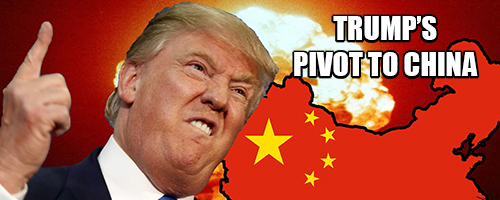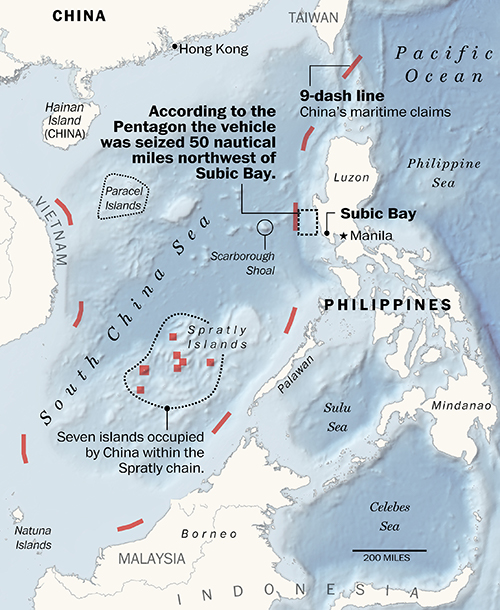
IPFS News Link • Trump Administration
Trump's Pivot to China
• https://www.corbettreport.comCorbett • 01/04/2017 • 2 Comments
 by James Corbett
by James Corbett
TheInternationalForecaster.com
January 4, 2017
Happy New Year, everyone!
Remember 2016? Remember Brexit? And Pokemon Go? And the (s)election circus? And the Russian propaganda hype?
How could you forget? These stories, along with the usual mix of staged terror events, staged leaks, and the general setting of the stage for the new(est) world order, will forever be cemented in the minds of an increasingly-traumatized public as the touchstones of a year that seemed to spiral out of control.
But of the many blink-and-you-probably-missed-it stories that slipped through the cracks of the 24/7 news cycle over the past year, perhaps none is quite as portentous as the story of the USNS Bowditch.
 The USNS Bowditch is an oceanographic survey vessel that was deployed by the US Navy in the South China Sea. On an otherwise routine mission to recover two unmanned naval drones in an area 50 miles from Subic Bay in the Philippines last month, the Bowditch encountered a problem. The vessel was approached by a Chinese Dalang-III class submarine, which dropped a boat in the water 500 yards from the Bowditch and scooped up one of the drones. The Bowditch radioed the Chinese ship to ask for the drone back, but the Chinese responded that they were busy and promptly sailed away.
The USNS Bowditch is an oceanographic survey vessel that was deployed by the US Navy in the South China Sea. On an otherwise routine mission to recover two unmanned naval drones in an area 50 miles from Subic Bay in the Philippines last month, the Bowditch encountered a problem. The vessel was approached by a Chinese Dalang-III class submarine, which dropped a boat in the water 500 yards from the Bowditch and scooped up one of the drones. The Bowditch radioed the Chinese ship to ask for the drone back, but the Chinese responded that they were busy and promptly sailed away.
These actions kicked off five days of diplomatic tit-for-tat, including some goading tweets from President-elect Trump and some biting op-eds from China's mouthpiece media. The Americans said this was a dangerous and unnecessary provocation, as the drone is a non-military vessel and only collects oceanographic data. The Chinese protested that they did nothing wrong and that the vessel was within the bounds of their territorial claim to the South China Sea. It seemed as if this little skirmish could be the start of a major international incident.
…But then the Chinese returned the vessel after some "friendly consultations" between the two countries, and that was apparently that.
On the surface this isn't much of a story at all. But dig deeper and you'll find that the incident reflects all of the trends we can expect to see taking shape during the Trump era. It takes place in the increasingly crowded (and contested) South China Sea. It stops just short of actual military confrontation between China and the US. And it features chest-thumping from both Trump and Beijing, with neither side exactly backing down. Welcome to the next four (to eight) years of life in the Asia-Pacific.
None of this is remotely surprising to anyone who has been paying attention, of course. So far Trump has made every possible signal that China is going to be the boogeyman for his administration—not Russia, as Hillary's neocon supporters had planned to target.
He has vowed to name China a currency manipulator on his first day in office.
He has tied continuing recognition of the "one China" policy to future trade concessions.
He has already accepted a phone call from the Taiwanese president, angering Beijing.
He has appointed Peter Navarro, author of such books as Death by China and Crouching Tiger: What China's Militarism Means for the World, to head his National Trade Council.
And he hasn't even been sworn in yet. All of this has led to the term "trade war" being bandied around by beltway pundits more often in the past few months than in the past few years (or decades).
The ironic thing about this is that if Trump does indeed go after China he will merely be furthering the agenda that Clinton herself fumbled during her time as Secretary of State. It was, after all, her speech in Honolulu in 2011 that formally kicked off the "Asia-Pacific Pivot," which was going to be the Obama administration's big foreign policy achievement of saying bye-bye to the Middle East and ni hao to the Asia-Pacific.


























